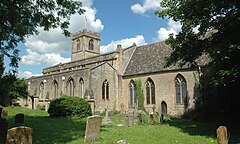Eynsham
| Eynsham | |
|---|---|
 St Leonard's parish church |
|
| Eynsham shown within Oxfordshire | |
| Population | 4,648 (parish, including Barnard Gate) (2011 Census) |
| OS grid reference | SP4309 |
| Civil parish |
|
| District | |
| Shire county | |
| Region | |
| Country | England |
| Sovereign state | United Kingdom |
| Post town | Witney |
| Postcode district | OX29 |
| Dialling code | 01865 |
| Police | Thames Valley |
| Fire | Oxfordshire |
| Ambulance | South Central |
| EU Parliament | South East England |
| UK Parliament | |
| Website | Eynsham Online! |
Eynsham /ˈɛnʃəm/ is an expanding village and civil parish about 5 miles (8 km) north-west of Oxford and roughly 5 miles (8 km) east of Witney, in Oxfordshire, England. The 2011 Census recorded the parish population as 4,648.
Eynsham grew up near the historically important ford of Swinford on the River Thames flood plain. Excavations have shown that the site was used in the Bronze Age for a rectilinear enclosure on the edge of the gravel terrace.
The Anglo-Saxon Chronicle records Eynsham as Egonesham and describes it as one of four towns that the Saxons captured from the Britons in AD 571. Evidence has been found of 6th and 7th century Saxon buildings at New Wintles Farm, about 3⁄4 mile (1.2 km) north of the present parish church. There is some evidence that Eynsham had an early minster, probably founded in the 7th or 8th centuries. The name is recorded in AD 864 (in the dative) as Egenes homme = "Ægen's enclosure or river-meadow".
In 1005 Aethelmar, kinsman of Aethelred II founded a Benedictine abbey on the site of the earlier minster. The first abbot was Ælfric of Eynsham, a prolific writer in Old English. By the medieval period Eynsham Abbey was one of the largest in the area, but it was dissolved at the Reformation in 1538 and only a few remains are still visible. The Church of England parish church of Saint Leonard dates from the 13th century. The church, which has a canonical sundial on the south wall, has been restored three times: by William Wilkinson in 1856 and H.G.W. Drinkwater in 1892 and most recently through the fundraising efforts of the whole community over a period of eight years in the 1980s.
...
Wikipedia

